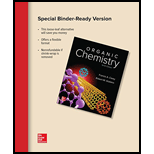
Interpretation:
A stepwise procedure with equations to show how to separate a mixture of
Concept Introduction:
Separation of the components of a mixture of organic compounds is based on the difference in their solubility in water and an organic solvent immiscible with water.
Advantage is taken of the difference in solubility of a basic (or acidic) compound and its conjugate base (or acid) in water.
Conjugate base of an acid or conjugate acid of a base are salts. Their ionic nature leads to a higher solubility in water as compared to a non-polar (or weakly polar) organic solvent. They are extracted into the aqueous phase containing an acid or a base from the solution of the mixture in a suitable organic solvent such as diethyl ether.
The base or the acid can then be recovered from the aqueous phase by neutralizing the conjugate acid (or base) with a strong base such as sodium hydroxide (or a strong acid such as hydrochloric acid). The recovered base (or acid) being insoluble separates out.
A neutral compound remains in ether solution (organic phase) from which it can be recovered by allowing ether to evaporate.
Trending nowThis is a popular solution!

Chapter 22 Solutions
Loose Leaf for Organic Chemistry
- Write the reaction of the following with 3% sodium carbonate. Note the observation and describe relative strength of phenol as an acid. a. 2% solution of phenol b. 1% solution of acetic acid c. Ethyl alcoholarrow_forwardEugenol is a natural product derived from the dried flower buds of the evergreentree, Eugenia aromatica. Briefly describe a procedure with reagents required toextract eugenol as a single component from the mixture of compounds presentin these flower buds.arrow_forward1. You have been given a mixture of toluene,aniline and benzoic acid dissolved in chloroform.explain in detail with the aid of a flow diagram and reaction schemes,how you would separate the mixture into pure componentsarrow_forward
- Phenols are less acidic than carboxylic acids, with values of pKa around 10. Phenols aredeprotonated by (and therefore soluble in) solutions of sodium hydroxide but not by solutions of sodium bicarbonate. Explain how you would use extractions to isolate the three purecompounds from a mixture of p-cresol (p-methylphenol), cyclohexanone, and benzoic acid.arrow_forwardBy Grignard reaction prepare 1,3 Diphenyl-2-butanol from secbutylbenzene, benzene and necessary chemical reagents. Obtain as intermediate 3 phenyl 1,2-epoxybutane. Report all stages of the synthesisarrow_forwardStarting with benzene, outline a procedure for synthesizing m-chloroaniline.arrow_forward
- How would you recover Benzoic acid from a mixture containing P-Chloroaniline and Biphenyl . Provide a balanced chemical equation for the reaction . Indicate physical states. Provide structures but not the molecular formula.arrow_forwardAfter a crude product is dissolved in 1.5 mL of hot solvent, the resulting solution is dark brown. Because the pure compound is reported in the literature to be colorless, it is necessary to perform a decolorizing procedure. Should you use pelletized Norit or powdered activated charcoal to decolorize the solution? Explain your answer.arrow_forwardAcid-base extraction :benzoic acid, p-nitroaniline and azobenzene in dichloromethane. 1.why is anhydrous sodium sulphate added to the organic solution? 2. Why was the water used for washing the precipitates on the funnels specified to be cold? 3. Why are the acidic extracts and basic extracts cooled before neutralization?arrow_forward
- You could extract caffeine from neutral organics by treatment with aqueous HCl (acid). Write the structure of the conjugate acid of caffeine (after treatment with HCl) and explain why it would dissolve in the aqueous layer.arrow_forwardAs a group, use your knowledge of acid-base extraction to come up with a plan to separate the following compounds from each other. Your plan should include specific solvents or reagents to be used and result in 4 isolated solids in the end. p-anisidine pyrene salicylic acid 2,3-xylenolarrow_forwardAn organic was subjected to sodium fusion and the resulting Lassaigne’s extract boiled with FeSO4 and acidified with concentrated H2SO4, yielding a Prussian blue color. Give an example of a compound fits this description?arrow_forward
 Organic ChemistryChemistryISBN:9781305580350Author:William H. Brown, Brent L. Iverson, Eric Anslyn, Christopher S. FootePublisher:Cengage Learning
Organic ChemistryChemistryISBN:9781305580350Author:William H. Brown, Brent L. Iverson, Eric Anslyn, Christopher S. FootePublisher:Cengage Learning
